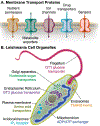Protean permeases: Diverse roles for membrane transport proteins in kinetoplastid protozoa
- PMID: 30590069
- PMCID: PMC6415942
- DOI: 10.1016/j.molbiopara.2018.12.006
Protean permeases: Diverse roles for membrane transport proteins in kinetoplastid protozoa
Abstract
Kinetoplastid parasites such as Trypanosoma brucei, Trypanosoma cruzi, and Leishmania species rely upon their insect and vertebrate hosts to provide a plethora of nutrients throughout their life cycles. Nutrients and ions critical for parasite survival are taken up across the parasite plasma membrane by transporters and channels, polytopic membrane proteins that provide substrate-specific pores across the hydrophobic barrier. However, transporters and channels serve a wide range of biological functions beyond uptake of nutrients. This article highlights the diversity of activities that these integral membrane proteins serve and underscores the emerging complexity of their functions.
Keywords: Channels; Drug sensitivity; Kinetoplastid parasites; Organelles; Sensing; Transporters.
Copyright © 2018 Elsevier B.V. All rights reserved.
Figures

Similar articles
-
Genetics and biochemistry of Leishmania membrane transporters.Curr Opin Microbiol. 2000 Aug;3(4):417-21. doi: 10.1016/s1369-5274(00)00114-4. Curr Opin Microbiol. 2000. PMID: 10972504 Review.
-
Drugs and transporters in kinetoplastid protozoa.Adv Exp Med Biol. 2008;625:22-32. doi: 10.1007/978-0-387-77570-8_3. Adv Exp Med Biol. 2008. PMID: 18365656 Review.
-
Flagellar membrane proteins in kinetoplastid parasites.IUBMB Life. 2015 Sep;67(9):668-76. doi: 10.1002/iub.1411. Epub 2015 Aug 25. IUBMB Life. 2015. PMID: 26599841 Free PMC article. Review.
-
The biology of kinetoplastid parasites: insights and challenges from genomics and post-genomics.Int J Parasitol. 2001 May 1;31(5-6):443-52. doi: 10.1016/s0020-7519(01)00154-0. Int J Parasitol. 2001. PMID: 11334928 Review.
-
The superfamily keeps growing: Identification in trypanosomatids of RibJ, the first riboflavin transporter family in protists.PLoS Negl Trop Dis. 2017 Apr 13;11(4):e0005513. doi: 10.1371/journal.pntd.0005513. eCollection 2017 Apr. PLoS Negl Trop Dis. 2017. PMID: 28406895 Free PMC article.
Cited by
-
Evaluation of Beauvericin's activity and mode of action against all life stages of L. tropica for cutaneous Leishmaniasis therapy.Front Cell Infect Microbiol. 2025 Jun 10;15:1599766. doi: 10.3389/fcimb.2025.1599766. eCollection 2025. Front Cell Infect Microbiol. 2025. PMID: 40557324 Free PMC article.
-
Broadening the spectrum of ivermectin: Its effect on Trypanosoma cruzi and related trypanosomatids.Front Cell Infect Microbiol. 2022 Jul 28;12:885268. doi: 10.3389/fcimb.2022.885268. eCollection 2022. Front Cell Infect Microbiol. 2022. PMID: 35967842 Free PMC article.
-
TransLeish: Identification of membrane transporters essential for survival of intracellular Leishmania parasites in a systematic gene deletion screen.Nat Commun. 2025 Jan 2;16(1):299. doi: 10.1038/s41467-024-55538-7. Nat Commun. 2025. PMID: 39747086 Free PMC article.
-
Transcriptomic analysis of the adaptation to prolonged starvation of the insect-dwelling Trypanosoma cruzi epimastigotes.Front Cell Infect Microbiol. 2023 Apr 6;13:1138456. doi: 10.3389/fcimb.2023.1138456. eCollection 2023. Front Cell Infect Microbiol. 2023. PMID: 37091675 Free PMC article.
-
An Update on African Trypanocide Pharmaceutics and Resistance.Front Vet Sci. 2022 Mar 7;9:828111. doi: 10.3389/fvets.2022.828111. eCollection 2022. Front Vet Sci. 2022. PMID: 35356785 Free PMC article. Review.
References
-
- Drew D, Boudker O, Shared molecular mechanisms of membrane transporters, Annu Rev Biochem 85 (2016) 543–72. - PubMed
-
- Zheng J, Trudeau MC, Handbook of Ion Channels, CRC Press; 2015.
-
- Thevelein JM, Voordeckers K, Functioning and evolutionary significance of nutrient transceptors, Mol Biol Evol 26(11) (2009) 2407–14. - PubMed
Publication types
MeSH terms
Substances
Grants and funding
LinkOut - more resources
Full Text Sources

